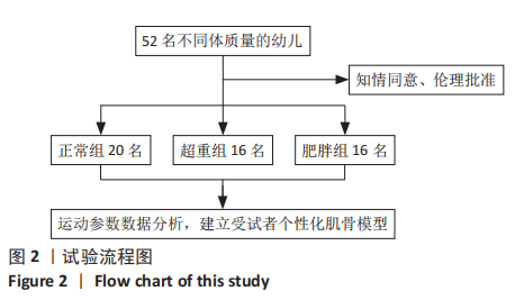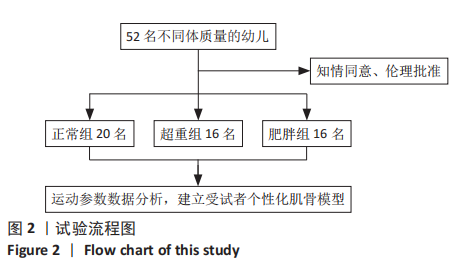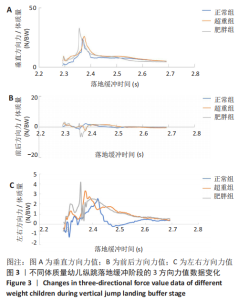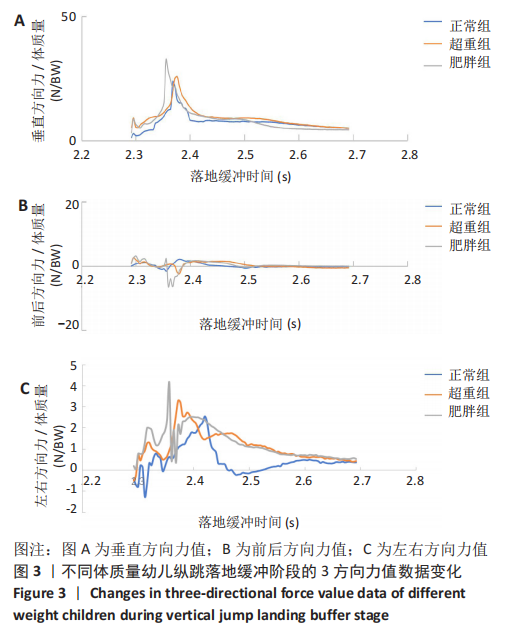Chinese Journal of Tissue Engineering Research ›› 2021, Vol. 25 ›› Issue (33): 5281-5287.doi: 10.12307/2021.314
Previous Articles Next Articles
Biomechanical characteristics of children with different body weights during vertical jump
Ji Zhongqiu, Li Jiahui, Zhao Panchao, Jiang Guiping
- Sports Biomechanics Laboratory of Sports Human Science, College of Physical Education and Sports, Beijing Normal University, Beijing 100875, China
-
Received:2020-10-23Revised:2020-10-24Accepted:2020-11-21Online:2021-11-28Published:2021-08-03 -
Contact:Li Jiahui, Master candidate, Sports Biomechanics Laboratory of Sports Human Science, College of Physical Education and Sports, Beijing Normal University, Beijing 100875, China -
About author:Ji Zhongqiu, MD, Professor, Sports Biomechanics Laboratory of Sports Human Science, College of Physical Education and Sports, Beijing Normal University, Beijing 100875, China -
Supported by:the National Social Science Foundation Project in 2020, No. 20BTY070 (to JGP)
CLC Number:
Cite this article
Ji Zhongqiu, Li Jiahui, Zhao Panchao, Jiang Guiping. Biomechanical characteristics of children with different body weights during vertical jump[J]. Chinese Journal of Tissue Engineering Research, 2021, 25(33): 5281-5287.
share this article
Add to citation manager EndNote|Reference Manager|ProCite|BibTeX|RefWorks
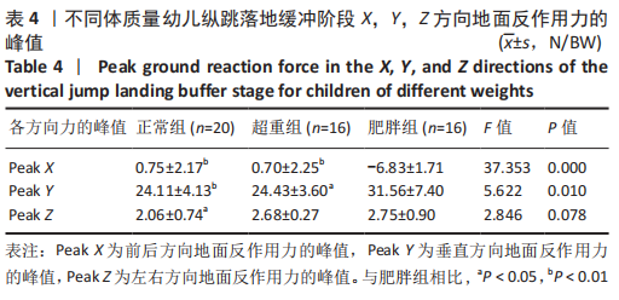
2.2 幼儿纵跳运动学参数 由表3可知,体质量正常组的纵跳高度均高于超重组(P < 0.05)和肥胖组(P < 0.01);肥胖组髋屈曲最大值小于超重组(P < 0.05)和正常组(P < 0.01);肥胖组髋屈曲最小值大于超重组(P < 0.05)和正常组(P < 0.01);正常组膝屈曲最小值大于肥胖组(P < 0.05);正常组踝屈曲最大值大于肥胖组(P < 0.05);肥胖组髋关节变化量小于正常组(P < 0.01)和超重组(P < 0.01);正常组膝关节变化量大于超重组(P < 0.05)和肥胖组(P < 0.01);肥胖组踝关节变化量小于正常组(P < 0.05);肥胖组躯干角小于正常组(P < 0.05)。 2.3 纵跳落地阶段地面反作用力峰值 表4为不同体质量幼儿纵跳落地阶段X,Y,Z共3个方向地面反作用力峰值的比较,由表4可知,肥胖组幼儿在纵跳落地阶段前后方向地面反作用力的峰值显著大于正常组(P < 0.01)和超重组 (P < 0.01);肥胖组垂直地面反作用力的峰值显著大于正常组 (P < 0.01)和超重组(P < 0.05);肥胖组左右方向地面反作用力的峰值显著大于正常组(P < 0.05)。图3为选取的正常体质量、超重和肥胖幼儿,在纵跳落地缓冲阶段3方向的垂直地面反作用力与体质量归一之后的曲线图。从图中可以看出超重和肥胖幼儿3方向力值的主要变化集中在整个落地缓冲阶段的前25%,正常幼儿的垂直方向和左右方向力的主要变化也是集中在落地缓冲阶段的前25%,正常幼儿前后方向力的主要变化则是集中在落地缓冲阶段的前25%-50%。 "
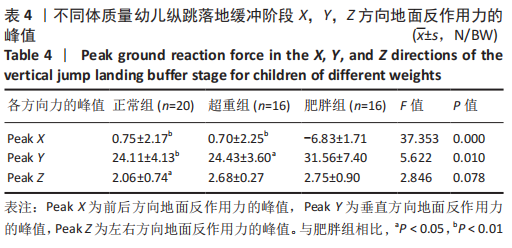
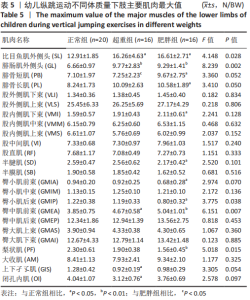
2.4 纵跳运动过程中下肢主要肌肉最大值 由表5可知,在完成纵跳动作时正常组比目鱼肌外侧头小于超重组(P < 0.05)和肥胖组(P < 0.05);腓肠肌外侧头小于超重组(P < 0.01)和肥胖组(P < 0.01);肥胖组腓骨短肌大于超重组(P < 0.05)和正常组(P < 0.05);正常组腓骨长肌、股内侧肌下束小于肥 胖组(P < 0.05);正常组半腱肌、臀小肌前束大于肥胖组 (P < 0.05);肥胖组臀小肌后束小于超重组(P < 0.05)和正常组(P < 0.05);正常组臀中肌前束小于超重组(P < 0.05)和肥胖组(P < 0.01);正常组梨状肌大于肥胖组(P < 0.01);正常组上下孑孓肌、闭孔内肌大于超重组(P < 0.05)。 "
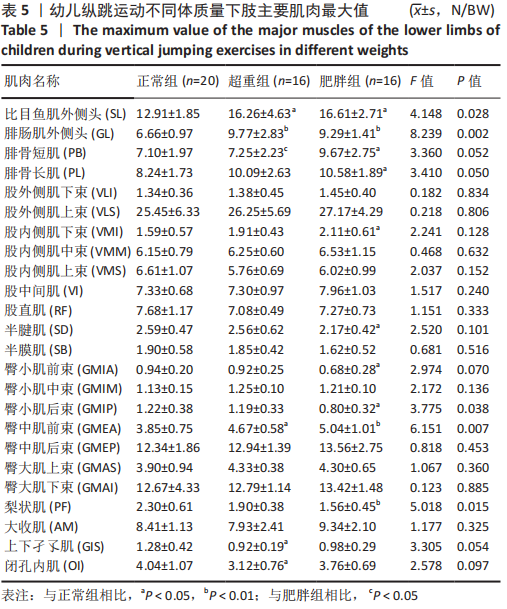
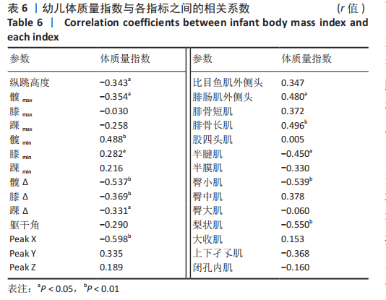
2.5 纵跳过程中体质量指数与运动学、动力学及肌力指标的相关性 从表6可见,体质量指数与膝关节最小角度呈现弱相关,与纵跳高度、髋关节最大角度、髋关节最小角度、膝关节和踝关节关节变化量呈现低度相关,与髋关节关节变化量呈现中度相关,而体质量指数与膝关节和踝关节最大角度、踝关节最小角度和躯干角的相关性无显著性意义(P > 0.05)。体质量指数与前后方向地面反作用力峰值呈现中度相关,与垂直方向和左右方向地面反作用力峰值的相关性无显著性意义(P > 0.05)。 体质量指数与腓肠肌外侧头、腓骨长肌和半腱肌呈现低度相关,与臀小肌、梨状肌呈现中度相关,与比目鱼肌外侧头、腓骨短肌、股四头肌、半膜肌、臀中肌、臀大肌、大收肌、上下孑孓肌和闭孔内肌的相关性无显著性意义(P > 0.05)。 "
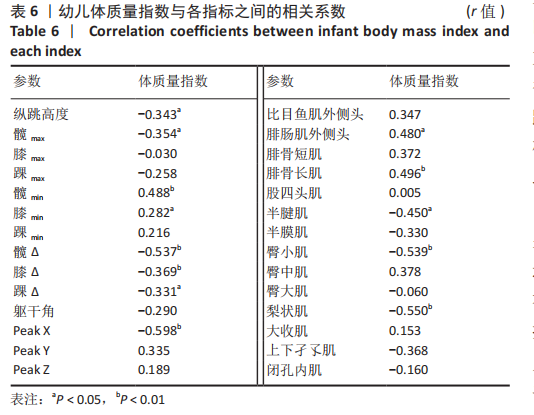
| [1] SANDERS RH, HAN A, BAKER JS, et al. Childhood obesity and its physical and psychological co-morbidities: a systematic review of Australian children and adolescents. Eur J Pediatr. 2015;174(6):715-746. [2] SKINNER AC, SKELTON JA. Prevalence and trends in obesity and severe obesity among children in the United States, 1999-2012. JAMA pediatr. 2014;168(6):561-566. [3] D’HONDT E, DEFORCHE B, DE BOURDEAUDHUIJ I, et al. Relationship between motor skill and body mass index in 5- to 10-year-old children. Adapt Phys Activ Q. 2009;26(1):21-37. [4] WELLS JC, FEWTRELL MS, WILLIAMS JE, et al. Body composition in normal weight, overweight and obese children: matched case-control analyses of total and regional tissue masses, and body composition trends in relation to relative weight. Int J Obes (Lond). 2006;30(10):1506-1513. [5] HAN A, FU A, COBLEY S, et al. Effectiveness of exercise intervention on improving fundamental movement skills and motor coordination in overweight/obese children and adolescents: a systematic review. J Sci Med Sport. 2018;21(1):89-102. [6] D’HONDT E, DEFORCHE B, GENTIER I, et al. A longitudinal study of gross motor coordination and weight status in children. Obesity (Silver Spring). 2014;22(6):1505-1511. [7] SIAHKOUHIAN M, MAHMOODI H, SALEHI M. Relationship between fundamental movement skills and body mass index in 7-To-8 yearold children. World Appl Sci J. 2011;15(9):1354-1360. [8] COWLEY JC, MCCAW ST, LAURSON KR, et al. Children who are overweight display altered vertical jump kinematics and kinetics from children who are not overweight. Pediatr Exerc Sci. 2020;32(1):2-8. [9] PAYNE G, 耿培新,梁国立.人类动作发展概论[M].北京:人民教育出版社,2008. [10] ITI M, JAAN E, HELENA G, et al. Motor performance in 5-year-old preschool children with developmental speech and language disorders. Acta paediatrica (Oslo, Norway: 1992). 2009;98(8):1334-1338. [11] SGRO F, NICOLOSI S, SCHEMBRI R, et al. Assessing vertical jump developmental levels in childhood using a low-cost motion capture approach. Percept Mot Skills. 2015;120(2):642-658. [12] Chu A, Hughes RE. A method to determine whether a musculoskeletal model can resist arbitrary external loadings within a prescribed range. Comput Method Biomec. 2010;13(6):795-802. [13] 李辉,宗心南,季成叶,等.中国2-18岁儿童青少年超重和肥胖筛查体质量指数界值点的研究[J].中华流行病学杂志,2010,31(6):616-620. [14] 赵盼超,文蕊香,李嘉慧,等.幼儿不同跑步着地方式的生物力学特征[J].中国组织工程研究,2020,24(20):3209-3216. [15] 刘沉.9-18岁儿童少年纵跳技能的运动学研究[J].中国体育科技, 2008,44(5):67-70. [16] FLUIT R, ANDEESEN MS, VERDONSCHOT N, et al. Optimal inverse dynamic simulation of human gait. Gait Posture. 2014;39:S42. [17] 刘述芝,胡志刚,张健.冲击载荷作用下运动员下肢动态响应的逆向动力学仿真[J].医用生物力学,2015,30(1):30-37. [18] 陈瑱贤,王玲,李涤尘,等.全膝关节置换个体化患者右转步态的骨肌多体动力学仿真[J].医用生物力学,2015,30(5):397-403. [19] 杨雨辰. 基于AnyBody的步态稳定性仿真分析及应用研究[D].天津:天津科技大学,2019. [20] CLIFF DP, OKELY AD, MORGAN PJ, et al. Proficiency deficiency: mastery of fundamental movement skills and skill components in overweight and obese children. Obesity (Silver Spring). 2012;20(5):1024-1033. [21] DUNCAN MJ, STANLEY M. Functional movement is negatively associated with weight status and positively associated with physical activity in british primary school children. J Obes. 2012;2012:1-5. [22] DUNCAN MJ, STANLEY M, LEDDINGTON WS. The association between functional movement and overweight and obesity in British primary school children. BMC Sports Sci Med Rehabil. 2013;11(5):1-8. [23] RAFFALT PC, ALKJAER T, SIMONSEN EB. Joint dynamics and intra-subject variability during countermovement jumps in children and adults. J Biomech. 2016;49(13):2968-2974. [24] LI-I W, DER-CHIA L, CHENFU H. Age effect on jumping techniques and lower limb stiffness during vertical jump. Res Sports Med. 2004;12(3): 209-219. [25] DOMIRE ZJ, CHALLIS JH. The influence of squat depth on maximal vertical jump performance. J Sports Sci. 2007;25(2):193-200. [26] FLORÍA P, HARRISON AJ. The influence of range of motion versus application of force on vertical jump performance in prepubescent girls and adult females. Eur J Sport Sci. 2014;14(sup1):S197-204. [27] CLARK JE, PHILLIPS SJ, PETERSEN R. Developmental stability in jumping. Dev Psychol. 1989;25(6):929-35. [28] JENSEN JL, PHILLIPS SJ, CLARK JE. For young jumpers, differences are in the movement’s control, not its coordination. Res Q Exerc Sport. 1994;65(3):258-268. [29] WELLS JC, FEWTRELL MS, WILLIAMS JE, et al. Body composition in normal weight, overweight and obese children: matched case-control analyses of total and regional tissue masses, and body composition trends in relation to relative weight. Int J Obes (Lond). 2006;30(10):1506-1513. [30] WIKSTROM EA, TILLMAN MD, SCHENKER SM, et al. Jump-landing direction influences dynamic postural stability scores. J Sci Med Sport. 2008;11(2):106-111. [31] VILLARRASA-SAPINA I, ALVAREZ-PITTI J, CABEZA RUIZ-R, et al. Relationship between body composition and postural control in prepubertal overweight/obese children: a cross-sectional study. Clin Biomech (Bristol, Avon). 2018;52:1-6. [32] FUKUZUMI A, TAKEHARA S, HASE K, et al. Muscle activity analysis in vertical jump by direct dynamics simulation with musculo-skeletal model. Japan Society of Mechanical Engineers. 2011. doI:10.1299/kikaic.77.1686 [33] YAHYA U, AROSHA SENANAYAKE SMN, NAIM AG. A database-driven neural computing framework for classification of vertical jump patterns of healthy female netballers using 3D kinematics–EMG features. Neural Comput Appl. 2020;32(5):1481-1500. [34] ABDELMOULA A, MARTIN V, BOUCHANT A, et al. Knee extension strength in obese and nonobese male adolescents. Appl Physiol Nutr Metab. 2012;37(2):269-275. [35] TOMLINSON D J, ERSKINE RM, MORSE CI, et al. The impact of obesity on skeletal muscle strength and structure through adolescence to old age. Biogerontology. 2016;17(3):467-483. [36] 徐亮亮,刘欣,王梅.低体质量、超重对幼儿身体素质的影响[J].中国体育科技,2015,51(1):127-131. (责任编辑:WJ,ZN,ZH) |
| [1] | Luo Lin, Song Naiqing, Huang Jin, Zou Xiaodong. Review and prospect of international research on preschool children’s movement development assessment: a CiteSpace-based visual analysis [J]. Chinese Journal of Tissue Engineering Research, 2021, 25(8): 1270-1276. |
| [2] | Fan Xinchao, Bao Wenjuan, Zhang Kai, Sun Xilong, Huang Teng, Gao Bo, Zhai Jinshuai, Zhou Yibin, Qiu Changmao, Li Wenyi, Li Xicheng. Diagnostic value of D-dimer, erythrocyte sedimentation rate and C-reactive protein in deep vein thrombosis of lower extremity after hip and knee arthroplasty [J]. Chinese Journal of Tissue Engineering Research, 2021, 25(33): 5324-5328. |
| [3] | Zhou Wenxing, Wang Lin . Effect of side cutting foot strike pattern and angle on the biomechanics of lower extremities [J]. Chinese Journal of Tissue Engineering Research, 2021, 25(32): 5184-5190. |
| [4] | Zhong Ruixin, Gao Haiyan, Huang Haoran, Teng Xueren, Dai Shiyou. Anatomical features of anterior cruciate ligament on MRI in children, adolescents and adults [J]. Chinese Journal of Tissue Engineering Research, 2021, 25(30): 4812-4817. |
| [5] | Tan Jiachang, Yuan Zhenchao, Wu Zhenjie, Liu Bin, Zhao Jinmin. Biomechanical analysis of elastic nail combined with end caps and wire fixation for long oblique femoral shaft fractures [J]. Chinese Journal of Tissue Engineering Research, 2021, 25(3): 334-338. |
| [6] | Li Kun, Li Zhijun, , Zhang Shaojie, Gao Shang, Wang Xing, Sun Hao, He Yujie, Wang Haiyan, Cai Yongqiang, , Xu Xuebin. Titanium plate placement for internal fixation of slopes in children aged 1-6 years: digital morphological analysis of mechanical support [J]. Chinese Journal of Tissue Engineering Research, 2021, 25(27): 4289-4293. |
| [7] | Li Kun, Li Zhijun, Zhang Shaojie, Gao Shang, Sun Hao, Yang Xi, Wang Xing, Dai Lina . A 4-year-old child model of occipito-atlanto-axial joints established by finite element dynamic simulation [J]. Chinese Journal of Tissue Engineering Research, 2021, 25(24): 3773-3778. |
| [8] | Lin Tianye, Yang Peng, Xiong Binglang, He Xiaoming, Yan Xinhao, Zhang Jin, He Wei, Wei Qiushi . Comparison of preoperative three-dimensional reconstruction simulation and intraoperative drawing of femoral osteotomy to measure rotation angle in vitro [J]. Chinese Journal of Tissue Engineering Research, 2021, 25(21): 3349-3353. |
| [9] | Lin Haishan, Mieralimu Muertizha, Li Peng, Ma Chao, Wang Li. Correlation between skeletal muscle fiber characteristics and bone mineral density in postmenopausal women with hip fractures [J]. Chinese Journal of Tissue Engineering Research, 2021, 25(20): 3144-3149. |
| [10] | Han Lei, Liu Haiying, Zhang Hao. Numerical analysis of the mechanical behaviors of cartilage in various levels of osteoarthritis in a gait cycle [J]. Chinese Journal of Tissue Engineering Research, 2021, 25(18): 2810-2815. |
| [11] | Qu Xingyue, Zhou Jianqiang, Xu Xuebin, Zhang Shaojie, Li Zhijun, Wang Xing. Finite element analysis of screw-bone anti-pullout in four models of anterior lower cervical fixation in children [J]. Chinese Journal of Tissue Engineering Research, 2021, 25(18): 2816-2821. |
| [12] | Liu Jiahui, Zhang Zhongjiu, Jia Dianxiang, Zhai Aoqing, Niu Guangyun, Jiang Haibo. Research status and clinical application of artificial knee joint testing machine [J]. Chinese Journal of Tissue Engineering Research, 2021, 25(18): 2895-2901. |
| [13] | Li Yang, Jiang Shuyun, Li Yiying, Yu Yan, Lu Xiaoying, Wang Danci . Spatiotemporal, kinematic and kinetic characteristics of gait in children with genu valgus [J]. Chinese Journal of Tissue Engineering Research, 2021, 25(15): 2303-2308. |
| [14] | Liu Yongyu, Xu Jingli, Lin Tianye, Wu Feng, Shen Chulong, Xiong Binglang, Zou Qizhao, Lai Qizhong, Zhang Qingwen . Medium-and long-term follow-up of Salter pelvic osteotomy and implant fixation for children with developmental hip dislocation [J]. Chinese Journal of Tissue Engineering Research, 2021, 25(15): 2380-2384. |
| [15] | Li Yonghe, Wang Xiankang, Meng Yu, Liu Lu, Zhang Chunqiu, Ye Jinduo . Mechanical analysis on the position difference of short-stemmed prosthesis in hip arthroplasty [J]. Chinese Journal of Tissue Engineering Research, 2021, 25(15): 2394-2399. |
| Viewed | ||||||
|
Full text |
|
|||||
|
Abstract |
|
|||||
